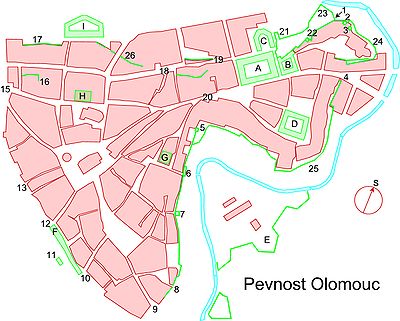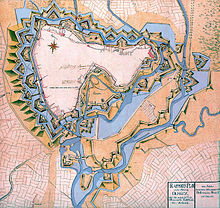Olomouc Fortress

| - Current development in the historic city center | |
| - Preserved parts of the Olomouc Fortress | |
| - The current course of the Mlýnský potok |
B - Army house (Dům armády)
C - Army bakery
D - Maria Theresa Armory (Zbrojnice)
E - Crown fortress (Korunní pevnůstka)
F - Water barracks (Vodní kasárna)
G - Place of the demolished Municipal armory
H - location of the demolished Moritz barracks
I - old town barracks
2 - prismatic defense tower
3 - round Roman tower
4 - place of the broken inner castle gate
5 - Judentor (Židovská brána)
6 - Michaels-projection (Michalský výpad)
7 - Henkertor (Katovská Branka)
8 - place of the demolished Blasiustors
9 - Location of the demolished Katherinentor
10 - Location of the demolished Lower Gate
11 - Theresientor
12 - Location of the demolished Middle Gate
13 - Location of the demolished so-called Putzentürl gate
15 - Location of the demolished Litoveler Tor
16 - Remains of the medieval fortification with powder tower
17 - Remains of the Renaissance fortifications with Rose Gate
18 - location of the demolished Rohel Gate (Rohelská brána) and the demolished water tower
19 - location of the demolished barbarian with remains of late Gothic castle complexes
20 - location of the demolished New Gate
21 - remains of the Locatelli Bastion
22 - former All Saints' Gate
23 - hospital bastion
24 , 25 , 26 - belt of medieval castles
The Moravian town of Olomouc has been known as the fortress of Olomouc since the 17th century , the defenses of which were expanded to fortify the Austro-Prussian border. They were gradually enlarged until the second half of the 19th century, until they became obsolete due to technical developments in artillery and were largely eliminated under Austrian rule.
Early middle ages
The first defenses date from the beginning of the Slavic settlement at the end of the 7th century. For the 9th and early 10th centuries, fortifications from the Great Moravia epoch in the area of the historic city center and in the periphery of that time have been identified.
After the fall of Great Moravia, Olomouc came under the influence of the Přemyslids , under whom the city was provided with a two-part fortification until the 12th century. At that time, the enclosed urban area extended from the cathedral hill, which is still called Olomoucký hrad [Olomouc Castle] to the Jewish gate ( Židovská brána ).
middle Ages
The actual city of Olomouc was founded under Magdeburg law between 1239 and 1243 south of the castle complex. Shortly thereafter, permanent fortification began. Their earliest written mention dates back to 1321. Parts of these walls including two towers have been preserved to this day. The area, which roughly corresponds to today's historic town center, was completely surrounded by a wall pierced by several town gates until the 14th century. Of these gates, the Judentor , which served defensive purposes until the 16th or 17th century, has been preserved to this day.
16th Century to Thirty Years War
In the 16th century, various elements of the fortification - including several city gates - were expanded or rebuilt. Since the Peace of Olomouc in 1479, the city was spared war for more than a hundred years until the outbreak of the Thirty Years' War .
Although the Olomouc Estates joined the Estates uprising on May 11, 1619 , the city was only involved in the fighting of the Thirty Years' War after the Battle of White Mountain . During the fighting, the city fortifications, which had only been marginally reinforced since the Middle Ages, turned out to be inadequate and outdated, so that just a few days before the Swedes arrived, a considerable piece of the city walls fell into the trench in front of it.
In the spring of 1642 the Swedish army under Lennart Torstensson invaded Silesia and advanced to Olomouc by June 10th. The Swedish army of only 8,000 men was able to force the imperial troops to withdraw towards Brno after only four days of siege . Despite the rapid capture, the Swedish attacks caused considerable damage, especially the northern fortifications. In order to be able to make out approaching enemies at a further distance, large forests in the vicinity of the city were cut down and suburbs razed to the ground. In the course of the occupation, the Swedes prepared Olomouc for their military purposes. So were z. For example, several houses in the city center were demolished and the number of city gates in operation was reduced to four (Blasiustor, Burgtor, Rohel-Tor and Mitteltor). New defenses, especially on the northern flank, were built. Until 1645, Olomouc was exposed to a permanent blockade by imperial troops, the strength of which fluctuated depending on the rest of the war.
The period from 1646 to the end of the Thirty Years' War, on the other hand, passed quietly in Olomouc and without any significant war events. For this reason, the Swedish occupiers invested more effort in repairing and expanding the run-down fortifications. As a result, the city was one of the most strongly fortified under the crown of Bohemia at the end of the war ; However, by no means did the Swedes' construction measures, which were mostly repairs carried out under time pressure and lack of money, reach the state of the art in military technology.
Austrian fortress city
During the reign of the Bohemian Queen Maria Theresa , Olomouc received strong bastions with ravelins , counter-guards and other external works.
In the Seven Years' War , Friedrich II wanted to attack Austrian territories in 1758 according to an old plan. He hoped to force Maria Theresa to peace by conquering the fortress of Olomouc. The main Prussian army marched into Moravia in May 1758. On May 20th, the fortress of Olomouc was surrounded by the army. A siege corps (approx. 8,000 men) was supposed to overcome the occupation. Meanwhile, Friedrich II secured the company against Daun's army .
Due to the favorable location of Olomouc and skillful maneuvers by the Austrian commander Ernst Dietrich Marschall von Burgholzhausen , Olomouc could not be completely enclosed. This enabled Field Marshal Daun to establish a connection with the fortress and to strengthen the garrison at any time. The fortress could no longer be taken, especially since a large Prussian supply transport coming from Troppau was successfully attacked by the Austrians under Ernst Gideon von Laudon on June 28th near Gundersdorf and on June 30th near Domstadtl . After this defeat, Frederick II was forced to give up the siege on July 1, 1758.
literature
- Miloslav Kuch-Breburda, Vladimír Kupka: Pevnost Olomouc. Fortprint, Dvůr Králové n. L. 2003, ISBN 80-86011-21-6 .
- Josef August Bartsch: Olomouc in 1758 and its earlier war history. Memorandum for the centenary of the relief from Olomouc on July 2, 1758. Slawik, Olmütz 1858, p. 42 ff. Digitized .
Web links
Individual evidence
- ↑ Miloslav Kuch-Breburda, Vladimír Kupka: Pevnost Olomouc. 2003, pp. 4-20.
- ↑ Miloslav Kuch-Breburda, Vladimír Kupka: Pevnost Olomouc. 2003, pp. 30-32.
- ↑ See the representation of the train to Moravia in Friedrich Schiller : History of the Thirty Years War , Book 5 on Wikisource .
- ↑ Miloslav Kuch-Breburda, Vladimír Kupka: Pevnost Olomouc. 2003, pp. 33-45.
Coordinates: 49 ° 35 ′ 38.5 " N , 17 ° 15 ′ 17.8" E



